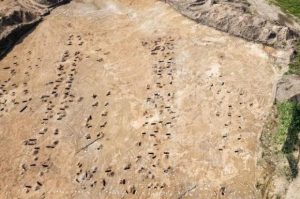Archaeologists uncovered a whole Iron Age village that also functioned in Medieval times, at the famous site of Jelling, Denmark.

The town is known for its heritage sites and artefacts, such as Jelling Church, the Jelling runic Stone, and two large burial mounds and becoming a centre of power under King Harald Bluetooth in the 10th century. Now, archaeologists have uncovered a village of almost 400 houses that span on an are of six hectares. Some of the houses are said to have been replaced by a new ones several times. According to archaeologists Katrine Balsgaard Juul of the The Vejle Museums (VejleMuseerne) in Southern Denmark, the houses were constructed in multiple periods of the Iron Age and all are dated to between 300 and 600 AD. Primarily, the houses were wooden and measured 33 in length and 5.5 in width. The researchers estimate that the village consisted of between eight and ten farms, and that the residents were farmers who worked on the surrounding land. Objects discovered on site suggest that some were skilled in iron and pottery production, which were typical of the period.

(after Esben Klinker Hansen, VejleMuseerne & Science Nordic)